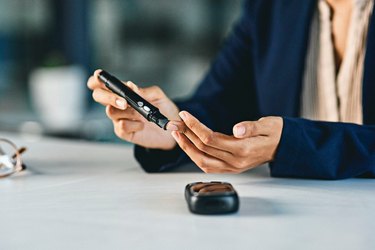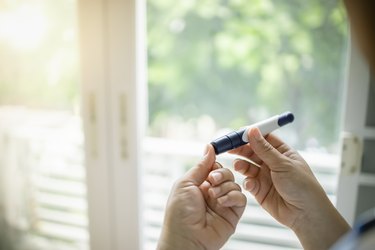
If you have diabetes, it's very important to keep your blood sugar, or glucose, levels within a healthy range to avoid certain health complications.
In general, the American Diabetes Association (ADA) says the target blood sugar level range for people with diabetes is between 80 and 130 mg/dL before a meal and lower than 180 mg/dL after a meal.
Video of the Day
Video of the Day
Still, because people's target blood glucose levels can vary, it's best to work with your doctor or health care provider to determine the right numbers for you.
A blood sugar over 400 milligrams per deciliter (mg/dL) is considered hyperglycemia, though, and may be a medical emergency, according to the Mayo Clinic.
Here's what to do if your blood sugar is over 400:
1. Test Again
If your blood sugar reading is over 400 mg/dL, there is a chance you have a false reading — particularly if you don't have other symptoms such as frequent urination or increased thirst.
For example, if there were food particles on your fingers or you used outdated or improperly stored test strips, you might have gotten an inaccurate reading.
2. Call Your Doctor
If you re-test your levels and your blood sugar is indeed above 400 mg/dL, follow the advice your doctor has given you — whether that includes taking extra insulin or drinking more water — and contact them for further treatment advice.
3. Test Your Urine for Ketones
Your doctor may ask you to test your urine for ketones (there are home testing strips designed for this purpose available at most pharmacies). High levels of these chemicals are a potential sign of diabetic ketoacidosis (DKA), a complication of hyperglycemia when your body is no longer able to use insulin to break down glucose for energy, per the ADA. This can be fatal.
Your doctor will tell you when you should perform the test, but the ADA says that, in general, you may want to check your urine for ketones when your blood sugar levels hit more than 240 mg/dL.
"In our clinic, if a person has blood sugar levels of over 300 mg/dL, we will check for urine ketones," says Susan Spratt, MD, an endocrinologist and associate professor of medicine at Duke University School of Medicine. "If their blood sugar levels are over 300 mg/dL — and certainly over 400 mg/dL — we're concerned that they may be going into diabetic ketoacidosis."
If your urine test reveals that ketones are present, call your doctor, who can give you further instructions. You may need to go to the emergency room to seek treatment right away.
The ADA says that if you have ketones present in the body, you shouldn't exercise. In this case, exercise can cause your blood sugar levels to spike even higher.
4. Call 911 if Your Symptoms Are Severe
As we noted above, untreated hyperglycemia can lead to diabetic ketoacidosis.
Beyond ketones in your urine, DKA symptoms include the following, per the Centers for Disease Control and Prevention (CDC):
- Fast, deep breathing
- Dry skin and mouth
- Flushed face
- Fruity-smelling breath
- Headache
- Muscle stiffness or aches
- Fatigue
- Nausea and vomiting
- Stomach pain
Even if you are not having severe symptoms, keep in mind that you could progress rapidly to DKA and that this could become a medical emergency at any time.
Additionally, even if you don't have symptoms, untreated hyperglycemia may lead to long-term health complications like nerve damage (diabetic neuropathy), damage to the blood vessels of the eye (diabetic retinopathy), kidney problems and heart problems, per the Mayo Clinic.
Warning
Without treatment, diabetic ketoacidosis can lead to a diabetic coma and death, so if you have symptoms, seek immediate medical attention. Diabetes statistics show the condition was the seventh leading cause of death in the U.S. in 2017, according to the ADA, so it's important to get medical care right away.
What Your Blood Sugar Levels Mean
Low | 70 mg/dL |
Normal (before a meal) | 80 to 130 mg/dL |
Normal (two hours after a meal) | Below 180 mg/dL |
High | 180 mg/dL or higher |
Dangerously high (seek medical attention) | 240 mg/dL or higher |
Causes of High Blood Sugar
According to the Cleveland Clinic, your blood sugar can spike (or swing) when you have diabetes for the following reasons:
- You're not taking the right dose of insulin or diabetes medication
- The amount of carbohydrates you're eating isn't balanced with your insulin medication dosage
- You're less physically active
- You're physically or emotionally stressed
- You're taking steroids, beta blockers, birth control pills or certain types of mental health medications
- You're experiencing the dawn phenomenon, which is when your body produces a surge of hormones early in the morning
How to Prevent Hyperglycemia
Other than seeing your doctor regularly and taking your medication as directed, there are a few things you can do at home to help prevent blood sugar spikes or hyperglycemia. These can include the following, per the Cleveland Clinic:
- Avoid sugary beverages: Drinks like juice, soda, sweet tea and sports and energy drinks have excess sugar and can increase your blood sugar quickly. Limiting them can help regulate your blood sugar levels. Try to limit other sugary foods that raise blood sugar, too, like candy.
- Choose complex carbohydrates: Eating too many carbs (especially simple, processed carbs) can contribute to high blood sugar. Try to choose nutrient-dense, high-fiber carbs like beans, berries, sweet potatoes and whole-grain bread.
- Eat balanced meals: Make sure you pair complex carbs with a lean source of protein and non-starchy vegetables, like broccoli or green beans. A well-balanced meal will help keep your blood sugar stable.
- Exercise reguarly: The ADA recommends starting with 30 minutes of cardio exercise three times per week. Then, work your way up to five times per week. You can try walking or strength training.
- Manage stress: Stress can negatively affect your blood sugar levels and can lead you to cope with unhealthy habits like drinking excessively or emotional eating. Managing your stress can help you take better care of yourself.
- Use your blood glucose monitor: If you've already been diagnosed with prediabetes or type 1 or type 2 diabetes, you're familiar with checking your blood glucose using a monitor. Make sure you're checking your levels before and after meals, or whenever you're feeling symptoms, to help you keep things in check.
- Quit smoking: Nicotine raises your blood sugar because it affects how your body responds to insulin. Quitting smoking can not only help you lower your blood sugar, but it can positively affect your overall health.
FAQ
Common Questions
At what sugar level can a diabetic coma occur?
If your blood sugar level goes above 600 mg/dL, you can develop a condition called diabetic hyperosmolar syndrome, which puts you at higher risk for a coma. If you go into a coma from high blood sugar, you're alive, but you can't wake up or respond to sights, sounds or other stimulation. Following your diabetes care plan and taking care of yourself can help prevent you from getting to dangerously high blood sugar levels that could lead to coma, per the Mayo Clinic.
Should I take insulin if my blood sugar is over 400?
If you've already been diagnosed with diabetes, you've likely received a diabetes care plan from your doctor. They can let you know if you should take insulin and how much to take if your blood sugar levels reach 400 or higher.
How many hours does it take for blood sugar to go down?
The amount of time it takes for high blood sugar to return to a normal range varies from person to person. One point of reference to help you get a better idea is the postprandial glucose test. This test is often done to determine if you have diabetes, and is done two hours after eating. Under healthy circumstances, your insulin and blood glucose levels should return to normal two hours after eating. If they don't, it could mean you have diabetes, per the University of Rochester Medical Center.
If you already have diabetes and have been prescribed insulin, though, your high blood sugar levels may be regulated fairly quickly with the use of the medication after meals.
- American Diabetes Association: "Hypoglycemia (Low Blood sugar)"
- American Diabetes Association: "DKA (Ketoacidosis) & Ketones"
- American Diabetes Association: "Understanding Blood Sugar and Control"
- American Diabetes Association: "The Big Picture: Checking Your Blood Glucose"
- U.S. National Library of Medicine: "Diabetic Ketoacidosis"
- ADA: "Statistics About Diabetes"
- Mayo Clinic: "Hyperglycemia in diabetes"
- Cleveland Clinic: "Hyperglycemia"
- CDC: "Diabetic Ketoacidosis"
- American Diabetes Association: "Hyperglycemia"
- Cleveland Clinic: "How to Lower Your Blood Sugar Naturally"
- American Diabetes Association: "Weekly Exercise Targets"
- Mayo Clinic: "Diabetic Coma"
- Mayo Clinic: "Hyperglycemia in Diabetes"
- University of Rochester Medical Center: "Two-Hour Postprandial Glucose"
- Mayo Clinic: "Blood Sugar Testing: Why, When and How"
- American Diabetes Association: Hyperosmolar Hyperglycemic Nonketotic Syndrome (HHNS)
- American Diabetes Association: DKA (Ketoacidosis) & Ketones
Is this an emergency? If you are experiencing serious medical symptoms, please see the National Library of Medicine’s list of signs you need emergency medical attention or call 911.


